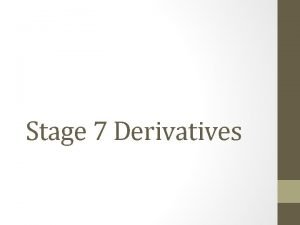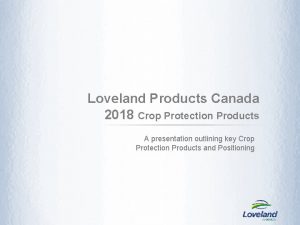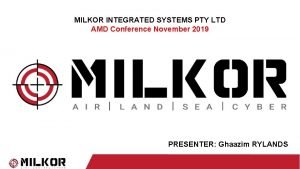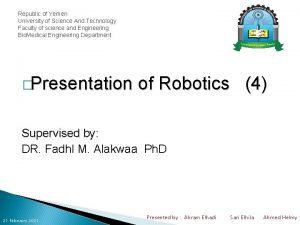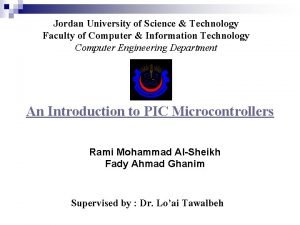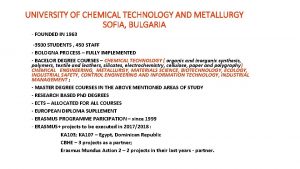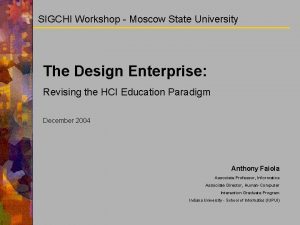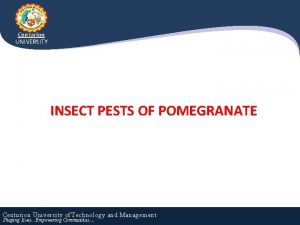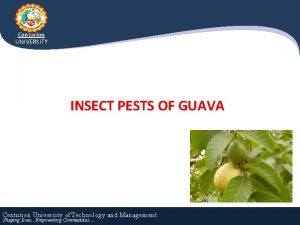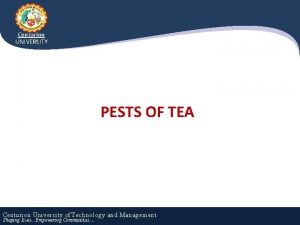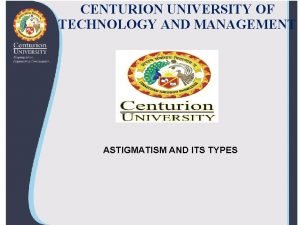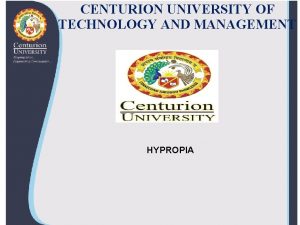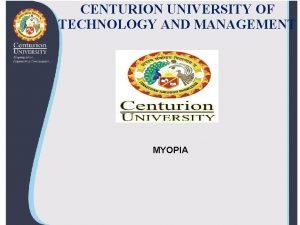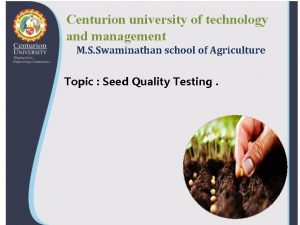Centurion university of technology and management M S











- Slides: 11

Centurion university of technology and management M. S. Swaminathan school of agriculture Topic : measures for pest and disease control during storage and godown sanitation.

STORAGE GODOWNS AND THEIR MAINTENANCE Seeds undergo deterioration due to aging in storage. This is accelerated by climatic factors and external biotic factors like insects and pathogen. In addition to seed borne pathogen and storage insects, seeds are damaged by birds and rats for their feed. Clean and hygienic godowns protect the seed from external insects and preserve the seed. Hence care should be taken in construction of godown. The points to be noted are as follows. • Seed godown should be in a place where transport facilities are easily available. • Seed godowns should not be constructed in areas near seashore. Since the high RH of atmospheric air accelerate the deterioration of seed. • Seed godown should not be constructed in low lying water stagnating areas. • Seed godown should be constructed in places where atmospheric RH is low, free circulation of air is possible, sunlight is adequate and elevated in nature. • The ventilators should be at bottom for free air circulation. • Ground moisture should not reach the floor. • Should be rat proof with wire mesh • Should not be near industries as smoke is injurious

In maintenance of seed in godown following points are to be considered: • Godown should be clean and dry • Seed bags should not be stacked directly on floor. Should be stacked on wooden ballets. • The height of the stack should not be more than 6 -8 bags. • Different seed lot should be kept separately. • Godown should be sprayed periodically once in a week or fortnightly with Malathion 50 EC (1 : 300 Chemical : Water) @ 5 lit. sq. m-1 or 0. 25% Nuvan @ 1 lit. 100 m 3 -1. • Altering the chemicals at weekly intervals will give better control. • Seed lots can be fumigated with Aluminium phophide @ 3 gm/cu. m in air tight condition for 7 days. This can be done as propylatic measure and on minimum infestation by insects. • Seed lots should be periodically (once in month) tested for seed quality. • Thiram @ 2 g kg-1 + carbaryl @ 200 mg kg-1.

• Based on seed testing result, seeds can be dried under sun for the removal of moisture. It reduces insect and pathogen infestation. • New seed lots should be kept away from old seed lots to avoid secondary infestation of insects. • Seeds should be treated with combination of fungicide and insecticide (eg. ) Thiram @ 2 g kg-1 + carbaryl @ 200 mg kg-1. • Frequent supervision of each and every lot is must. • Seed bag should be restacked once in 3 months for free aeration. • Instead of gunny bags low cost interwoven polythene bags should be used to prolong the life of seed. • Pesticides, fungicides, fertilizers, rejects should not be stored with seed. • Each lot should be labeled accurately and registers for stocks should be maintained. • Per acre or per hectare packing (small) is preferable for easy handling and effective supervision.

STORAGE INSECT MANAGEMENT • Maintenance of store house hygiene • Cracks and crevices around corners have to be brushed to eliminate hiding pests. All debris should be removed. Provision of wire meshes to windows, ventilators, gutters, drains to prevent entry of rats, squirrels, birds, etc. • Reduce the moisture content of seed to prevent insect build up (usually below 10%). Previously used bags, bins, etc. should be dried in the sun repeatedly. • Elimination of conditions which favour storage pests. Uniformly graded seeds should be used, broken seeds should be removed before bagging since they favour pest build up. Stitching of all torn bags, filling bags up to the brim, no loose packing. • Surface treatment of storehouse before storage with malathion dust 4% @ 25 g/sq m or malathion 50% EC spray @ 10 ml/lit of water and 3 lit of solution per sq. metre. • Good dunnage by arranging wooden planks or bamboo poles or spreading thick polythene sheets on the floor. Treatment of dunnage materials with malathion as specified, arrange the bags in criscross pattern with a maximum of 15 bags and provide adequate space between the roof and the seed bags.

Prophylatic treatment of seeds Application of malathion 4 per cent dust 25 g/sq metre or malathion 50 per cent EC 10 ml per litre of water and 3 litres of spray solution for 100 sq. m. The chemicals have to be sprayed on the walls and floors and the treatment has to be repeated based on the extent of flying and crawling insects. Chemicals Two chemicals are widely used : Phosphine and Methyl Bromide. Others are dichlorvos, Carbondioxide, Ethylene oxide and HCN. Phosphine : Available in a solid form (0. 6 g pellets, 3 g tablets). The active ingredient is Aluminium phosphide mixed with Ammonium carbonate and Paraffin. After exposure to the atmosphere, the pellets decompose and release the active substance, hydrogen phosphide (PH 3), which has the same specific weight as air, and is thus evenly distributed in the fumigated material or chamber. Phosphine is also able to penetrate bags, carton boxes and other containers. It must be borne in mind that fumigation particularly repeated fumigation, may seriously reduce the vigour and viability. This is particularly true for seeds with a higher moisture content of 14 per cent. Seeds with moisture content above 14 per cent should be dried, before fumigation.

Samples of seeds have to be drawn at fortnight intervals and the infestation can be classified as follows based on insects found per kg of sample. When there is no pest free Upto 2 insects Mild More than 2 insects severe The fumigant has to be chosen and the requirement worked out on the following guidelines : Aluminium phosphide: Three tablets of 3 g each per ton of seed for cover fumigation (only selected blocks of bags) Twenty one tablets of 3 g each for 28 cubic metres, for shed fumigation (entire godown). Period of fumigation - 5 days. The major advantages of Phostoxin are that it lacks residues and does not affect flavor or germination and is easy to handle.

Methyl bromide: Above 5. 6 o. C, methyl bromide is in the gas phase and is available in cylinders similar to those used for cooking gas. Since, it is odorless, other gases such as chloropicrin are sometimes added to facilitate detection of leaks. Because methyl bromide is 3. 5 times heavier than air, care has to be taken that it is properly distributed within the goods to be fumigated (fan can be used). The recommended dosage is 20 g/m 3 for 24 -48 hrs. Special safety measures are required, since methyl bromide is absorbed through the skin. It tends to accumulate in commodities which are important whenever repeated fumigation is necessary. Equipment Gas-proof plastic sheets with at least 50 cm overlap firmly pressed to the ground with sand, iron bars, or other weights are frequently used. Gas escape results in reduced insecticidal effect and is a hazard to users. A cement floor is necessary to prevent gas escape through soil. Care must be taken that the fumigation area is properly aerated and fans sometimes help. If a store’s door and windows can be hermetically sealed, fumigation of the entire store is possible. Most stores, however, allow gas to escape through other openings. Silos are usually good fumigation facilities.

When large quantities must be fumigated within a short time, a vaccum fumigation chamber is appropriate. These chambers are available in sizes between 1 and 50 m 3 , and sometimes as a plant of upto 6 x 50 m 3 , equipped with common fans, pumps and other equipment. The insecticides used are methyl bromide or ethylene oxide. Safety Face masks with a proper canister should be used, especially during the aeration process. When handling Phostoxin, cotton gloves should be worn. Gas concentration can be checked with a Halide gas detector for methyl bromide and with a tube detector (Draeger) for Phostoxin. A warning sign should be clearly visible to prevent people from inadvertently removing plastic sheets or entering a building under fumigation.

Rodent Management in Store Houses Provide of wire mesh to windows, ventilators, drains and leave no gaps to doors. Use rodent baits with multi dose or anticoagulant rodenticides. The bait may be prepared as follows: Cereal flour 450 gm All edible oil 10 gm Powdery jaggery 15 gm Anticoagulant or rodenticide such as coumarin 25 gm Replace the consumed bait daily. If needed the single dose or acute poison bait may be prepared as follows : Food material 97 gm Edible oil 1 gm Zinc phospate 2 gm Before providing the poisoned zinc phosphide bait, the plain or non-poisoned bait are to be provided for two or three days to make the rats accept the bait

Thank you
 Intelligible
Intelligible Mcpa amine 600
Mcpa amine 600 Milkor centurion
Milkor centurion Faith of the centurion luke 7
Faith of the centurion luke 7 Usth
Usth Ulsan national institute of science and technology
Ulsan national institute of science and technology The university of science and technology yemen
The university of science and technology yemen Jordan university of science and technology
Jordan university of science and technology Jordan university of science and technology
Jordan university of science and technology University of chemistry and technology in prague
University of chemistry and technology in prague University of chemical technology and metallurgy
University of chemical technology and metallurgy Moscow state university of design and technology
Moscow state university of design and technology
